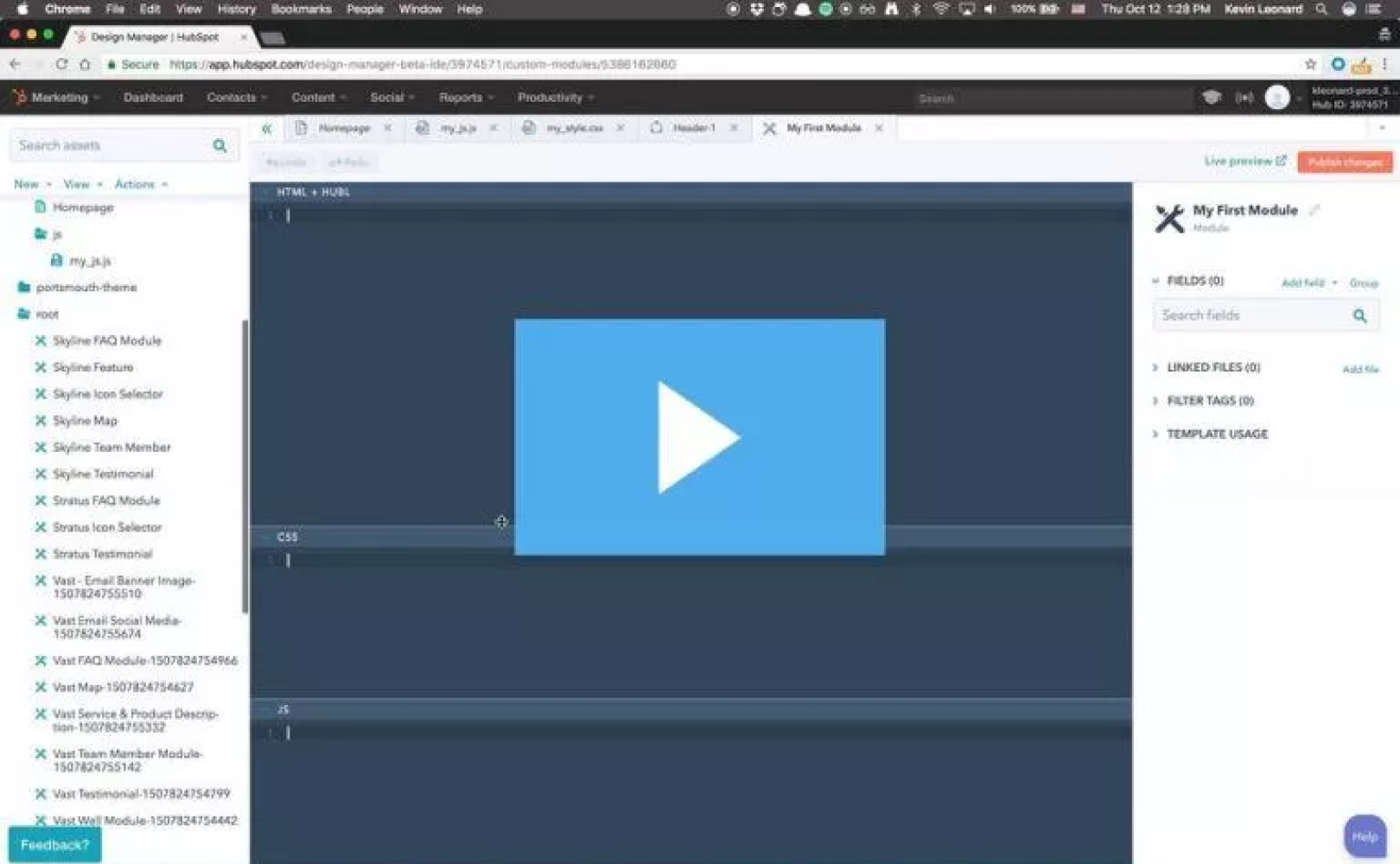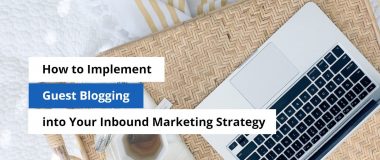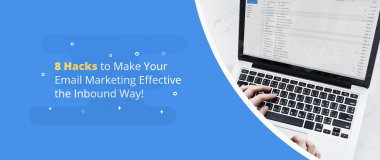When it comes to inbound marketing, there are average marketers and marketers that use HubSpot. It is one of the most powerful and easy-to-use marketing tools that you can use to grow your business and learn the best inbound marketing tactics in the process.
If some of the most successful small businesses didn’t use Hubspot, they wouldn’t spark their growth. The entire process of using HubSpot is focused on learning, whether that’s via marketing tools or taking courses in the Academy. By using HubSpot, your business can learn a lot about inbound strategies and in this article, we’ll show you exactly how.
What Is HubSpot?
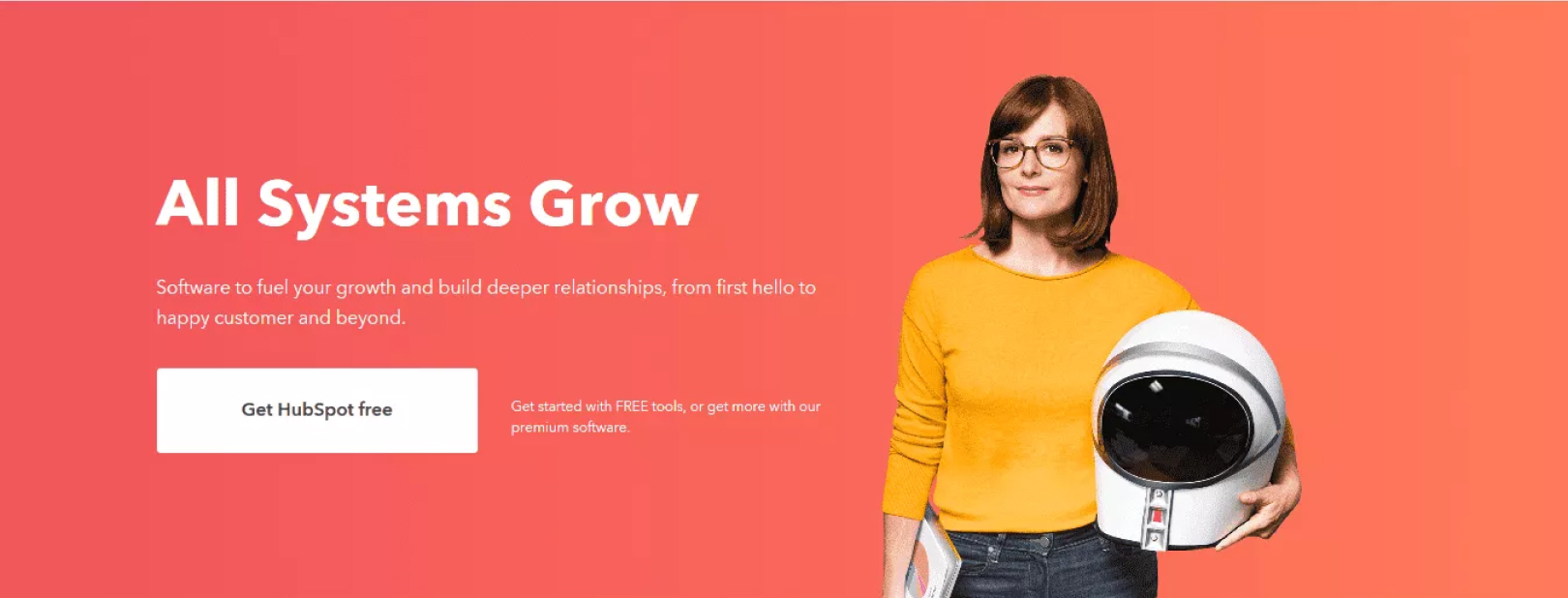
HubSpot is an inbound marketing and sales software that helps companies attract visitors, convert leads, and close customers. With HubSpot, you optimize your webpage into a lead magnet and engage with your potential customers by developing landing pages, CTAs, and personalized email campaigns.
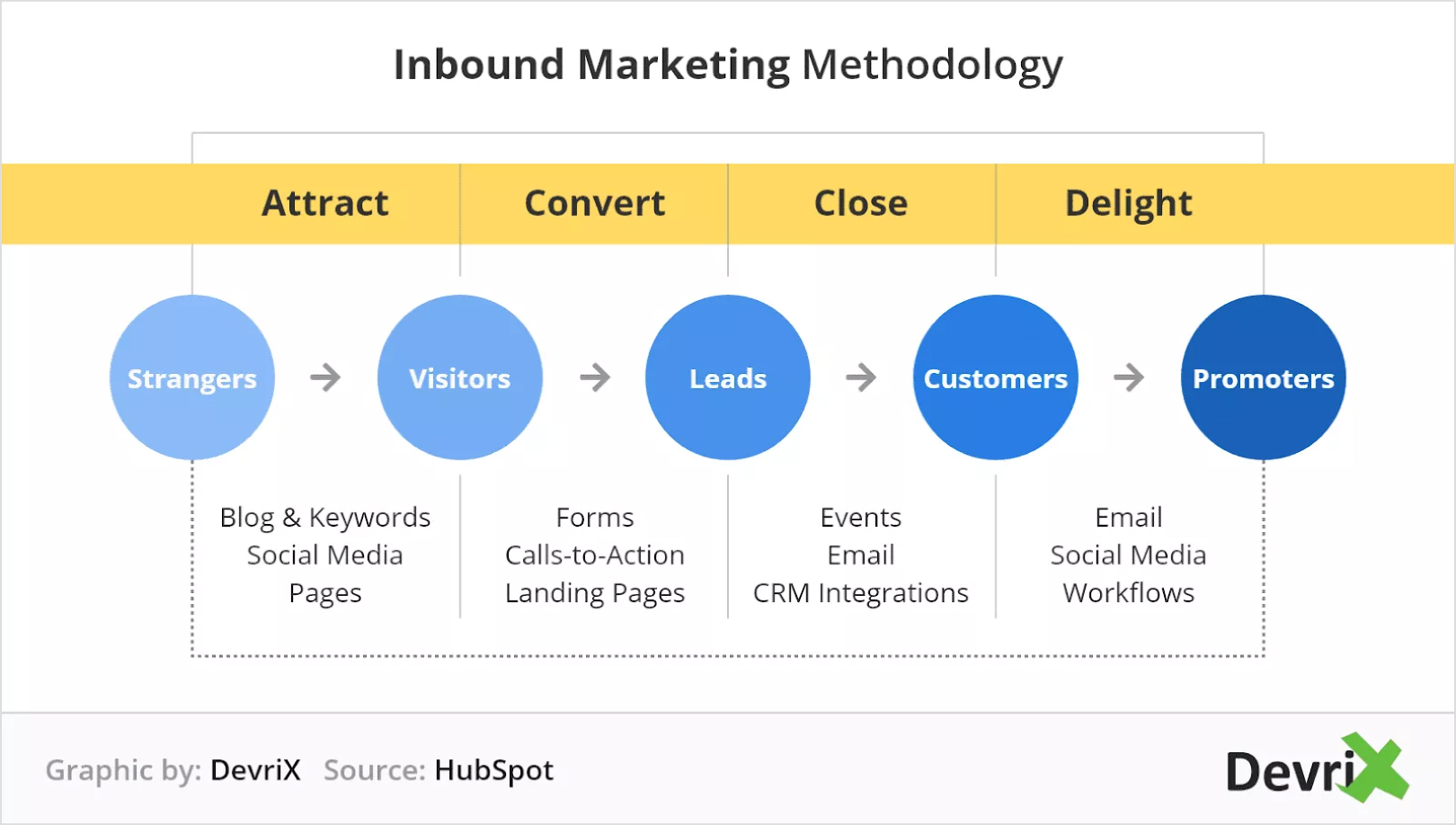
Inbound marketing consists of the following three stages:
- Attract – Develop articles, ebooks and video content that answers the customer’s pain points and questions. After that, optimize the content for search engines.
- Convert – Turning web traffic into qualified leads. The use of landing pages for content and product/service promotion. Attracting prospects with clear CTAs.
- Close – The number of leads is not as important as how many leads you’ll turn into paying customers.
- Delight – Turning leads into delighted customers. Collecting the data that they share with you and helping them to solve their problems.
You can execute each of these phases with just one platform – HubSpot.
The platform has every tool that you need for a successful inbound marketing process and award-winning services to help you master inbound marketing, including:
- Email Marketing
- Web Design
- SEO
- Marketing Automation
- Landing Pages
- Analytics
- Social Media
- Blogging

Why Is HubSpot Great for Inbound Marketing?
HubSpot is a popular platform for companies looking to drive their online marketing efforts. Not only does it offer a wide range of user-friendly features that make online marketing easier, but it also comes with excellent customer support and resources.
Whether you are just getting started with online marketing or are looking for more advanced tools and capabilities, HubSpot can help you achieve your goals quickly and easily. The simplicity of this tool’s interface makes it simple to get started generating results for your company, and the dedicated customer service staff is always ready to assist.
For the past several years, HubSpot has been investing heavily in R&D to create new features and improve existing ones. This commitment to continual innovation has paid off, with the company now boasting an impressive suite of tools for marketers and sales professionals alike. In 2022 and beyond, HubSpot plans to refine its current offerings and add even more great features to its robust platform.
HubSpot has everything you need to succeed in today’s ever-changing digital world, whether you’re a seasoned marketer or just getting started with online marketing. There’s no excuse not to give this all-around platform a shot now that it’s so affordable and provides a wide range of subscription choices.
A Learning Center
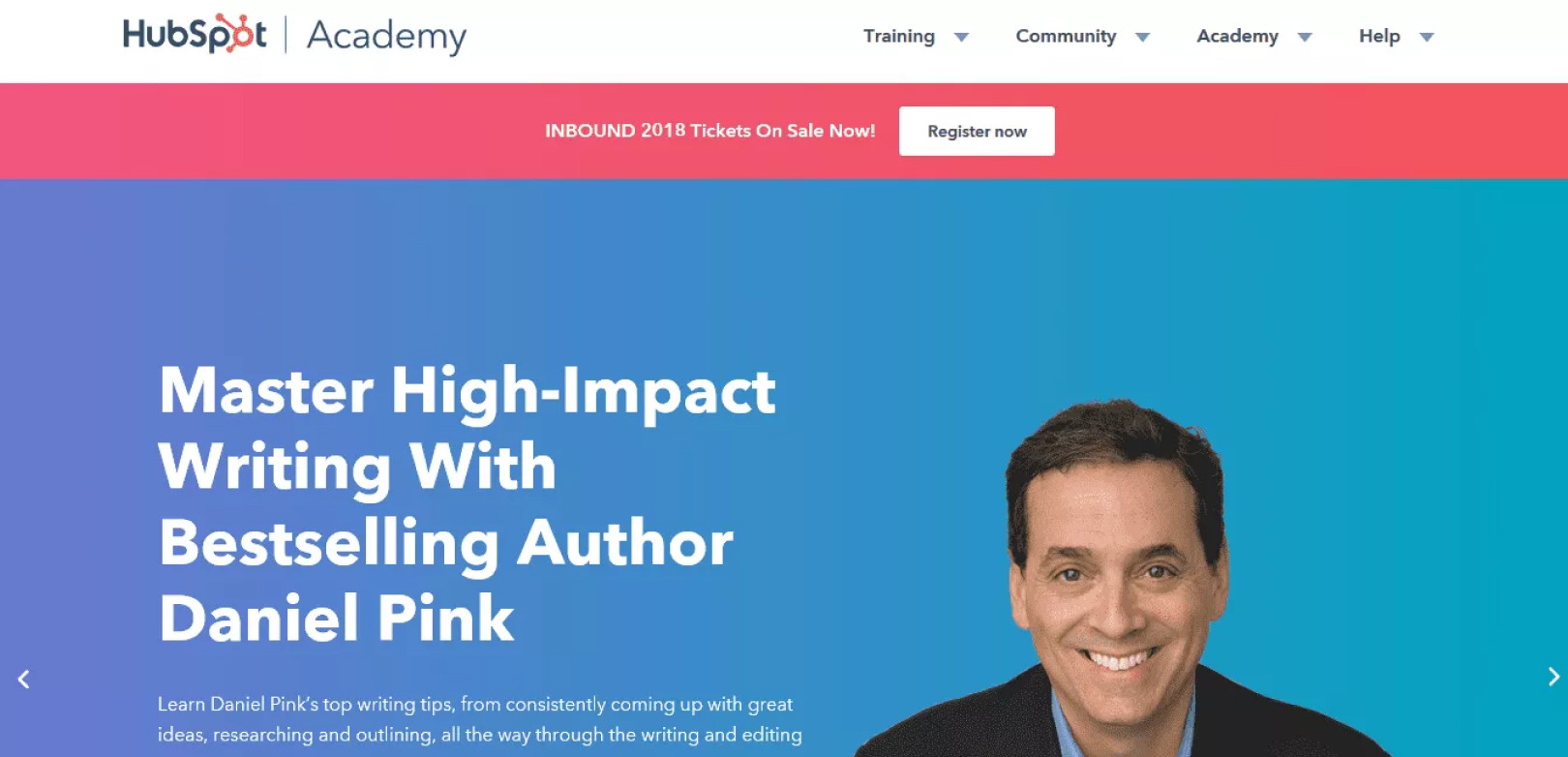
The HubSpot Academy is a leader in inbound marketing and sales education. Starting from 2012, the Academy’s main goal is to transform the way people and companies grow by offering online training in the form of courses, projects, certifications, and software training.
The Inbound Certificate is the official HubSpot leader of the inbound movement, and there are tens of thousands of certificates awarded per year to marketing professionals that consume content translated into 4 different languages and developed by some of the top marketing experts in the world.
Developing a RoadMap by Learning About Inbound Marketing
By developing goals and a roadmap that will guide you in achieving them, you’re bound to achieve inbound marketing success. The education that you’ll get from the Academy will help you understand modern inbound marketing and build your roadmap, and additionally, assist you in getting your HubSpot certifications.
Inbound Marketing
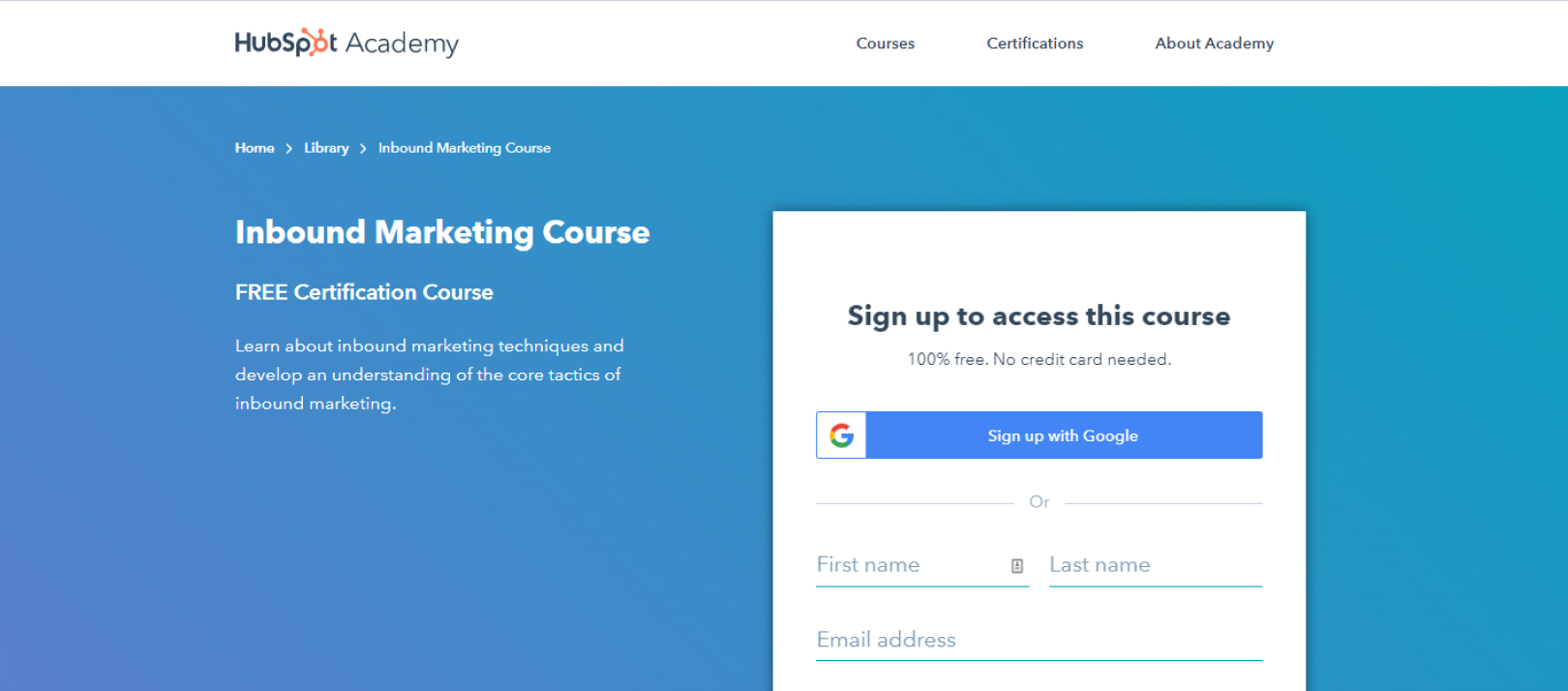
HubSpot’s Inbound marketing course is where you should start the learning process. This will provide you with the basics and building blocks that you’ll need to execute the perfect inbound marketing strategy.
It will teach you all about the fundamental shift in marketing that inbound is, including how to attract people to your business, convert web visitors into customers, close leads and delight customers with your content/offers.
The Inbound Certification features HubSpot executives that teach you how to run an inbound business, from marketing to sales, and also how to offer your services.
Inbound Sales

This is an excellent course if you have a sales team that needs to adopt the inbound and consultative sales approach. Your team will gain holistic knowledge and overview of inbound sales and email marketing skills.
With the Sales Strategy course you’ll be able to build your strategy on a framework and methodology that aligns marketing and sales, and supports predictable revenue growth for your organization through closed-loop reporting.
HubSpot also includes the Sales Software learning track that will teach you all about using the HubSpot CRM and the Sales features that you’ll have at your disposal.
Email Marketing
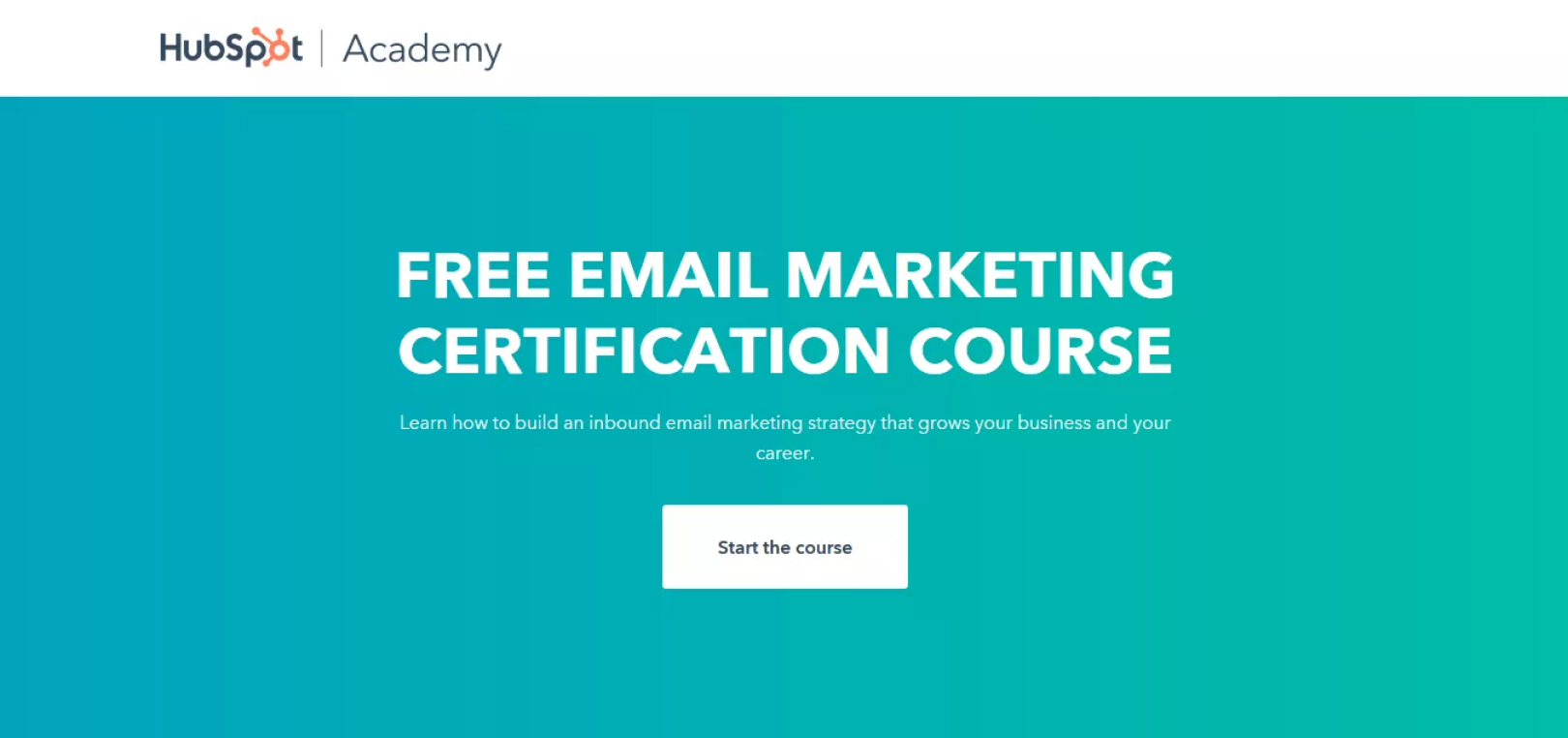
Enhance your inbound strategy further and bring more results by learning all about the latest email marketing best practices and contact research tactics. With the email marketing course, you’ll be able to build your email marketing strategy based on HubSpot’s framework and methodology that aligns marketing and sales, and supports predictable revenue growth for your organization through closed-loop reporting.
Content Marketing

You can’t do inbound marketing without producing quality content. The content is the fuel of your inbound strategy. HubSpot’s Content Marketing Course is an excellent addition to your marketing arsenal. You’ll learn from experts in the field how to create content that delights people and inspires them to trust your brand.
This course will also teach you how to scale your content marketing process and how to promote your content to attract and convert leads into customers. The classes include content marketing topics, from process understanding to generating content and strategy planning, and much more.
Social Media
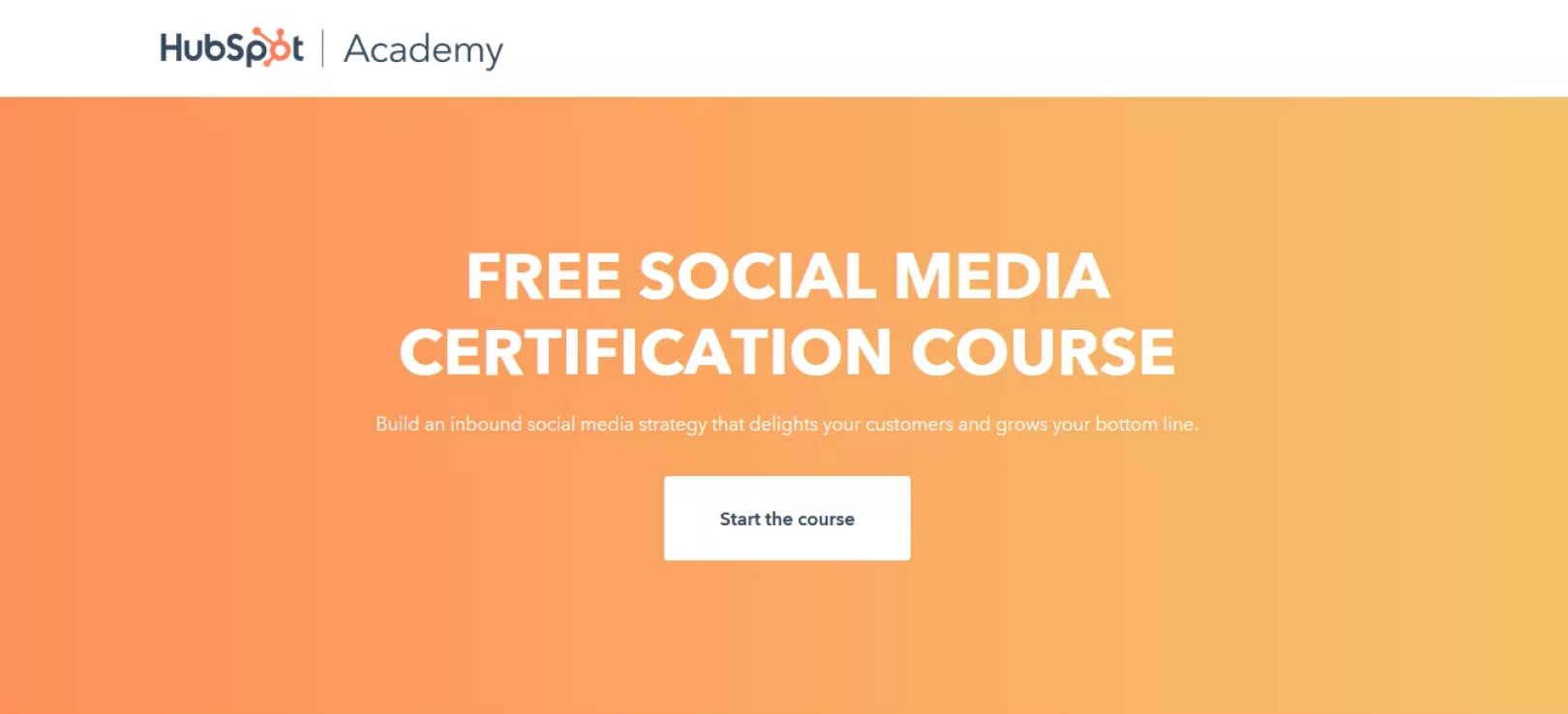
Social media embodies inbound marketing ideas turned into posts on the top social media channels. It is rooted in every part of your inbound strategy. It helps to fuel your contacts/leads list, brings traffic to your website, helps and interacts with your customers and builds your brand reputation. Most importantly, social media will help you to develop a relationship with your prospects.
HubSpot’s set of social media lessons covers everything from social media strategy, social listening and moderating, social content, extending your reach, digital marketing, measuring ROI, and much more.
HubSpot Design

If you want to convert leads, you need to have a flawless website design. You’ll need brilliant landing pages and email newsletter templates. With the Hubspot Design track, you’ll learn how to use the tools to unlock the full potential of your website and design past CSS and HTML codes.
It is an excellent investment, especially if you have a dedicated design team at your disposal. Design experts will teach you all about the growth-driven design methodology that will help you optimize your web presence for success.
Additional Resources to Learn from
Of course, HubSpot wouldn’t be where they’re now if it wasn’t for the constant value that they provide to their users, marketers, and readers. Besides courses, HubSpot also has a free resources page that has guides, ebooks, cheat sheets and videos, and an extremely valuable blog that is categorized in several categories, including inbound tactics, social media, content marketing, and design.
Everything that you’ll learn will help you to create a strong inbound marketing strategy and maximize the HubSpot’s tools used for your business growth.
Using HubSpot Inbound Campaign Tool

The Campaign tool will allow you to align your marketing efforts around your goals and products/services. You can connect your campaign with landing pages, calls-to-action, emails, blog posts, social messages, keywords, pay-per-click visits, traffic from other sources, and workflows.
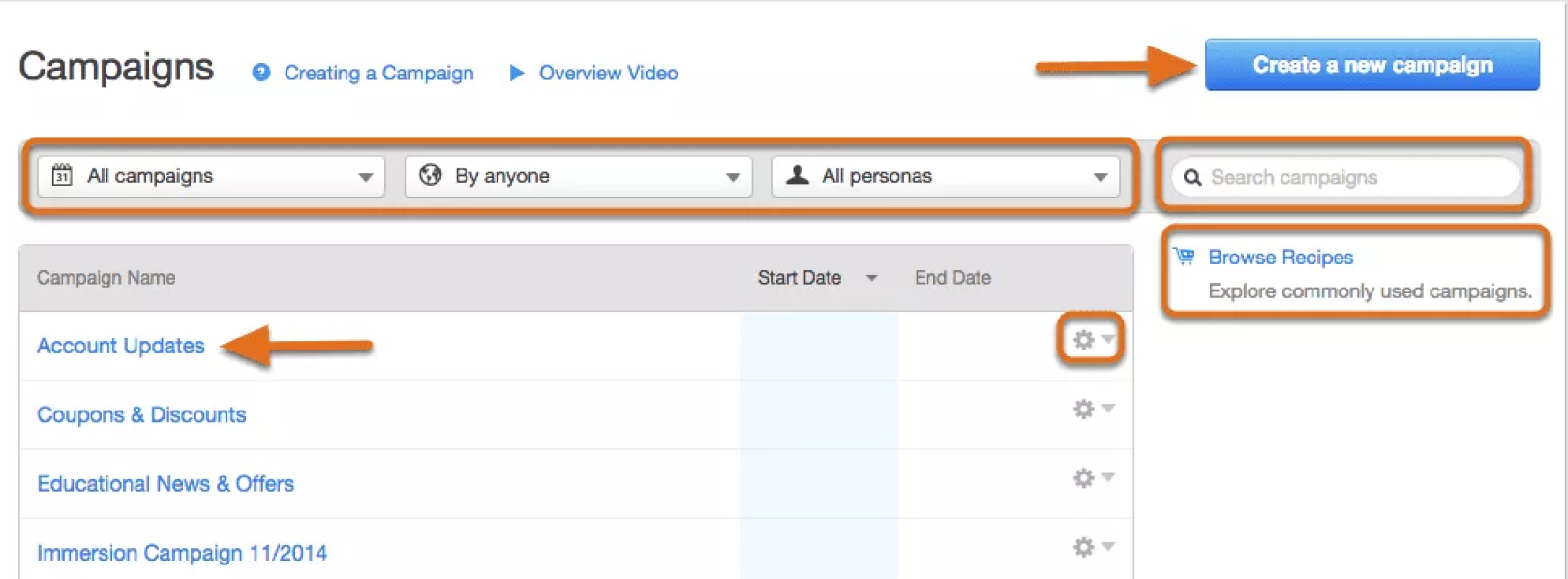
Your campaigns can be focused on:
- Verticals – Target a specific business niche or group of people in an industry.
- Product lines– A group of related products made by one company.
- Demographics – Characteristics of a particular population (age, gender, occupation, etc.).
- Personas – Fictional, generalized characters that encompass the various needs, goals, and observed behavior patterns among your real and potential customers. They serve to help you understand your customers better.
Campaigns are crucial because they help you attract prospects and help you form an approach that will have the biggest effect by bringing more web traffic, leads, and customers to your company. HubSpot allows you to organize and optimize your campaigns to be aligned with your marketing channels, which in turn, makes it easier for you to measure the results from your campaigns.
HubSpot Blog Tool
The HubSpot blogging tool is a simple and streamlined option that servers for your business blog publishing campaign. With integrated analysis and reporting, personalizable options and settings, and built-in SEO best practices, the Blog tool takes the hard work out of content creation and puts you in control of things.
An engaging blog with quality articles is essential for your inbound marketing strategy and HubSpot makes writing and SEO for your posts easy. The main features of the HubSpot’s Blog tool are:
- Blog Post – Individual blog posts that make up your HubSpot blog or blogs. These posts are displayed in various listings (by publish date, author, and by topic).
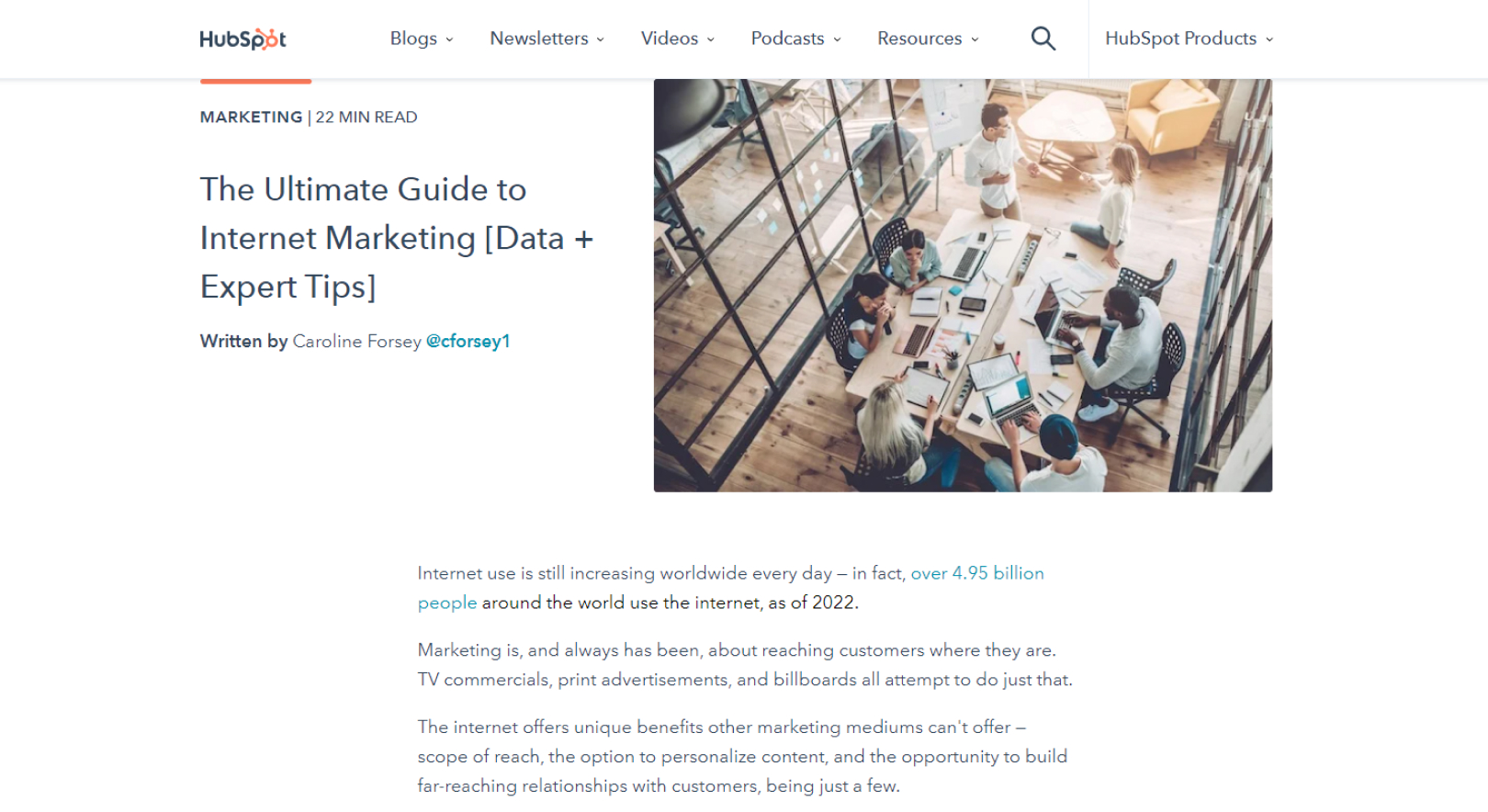
- Blog Listing – Your individual posts are grouped together into blog listings. For example, your blog’s homepage will generally be a listing of your most recent posts, listed chronologically.
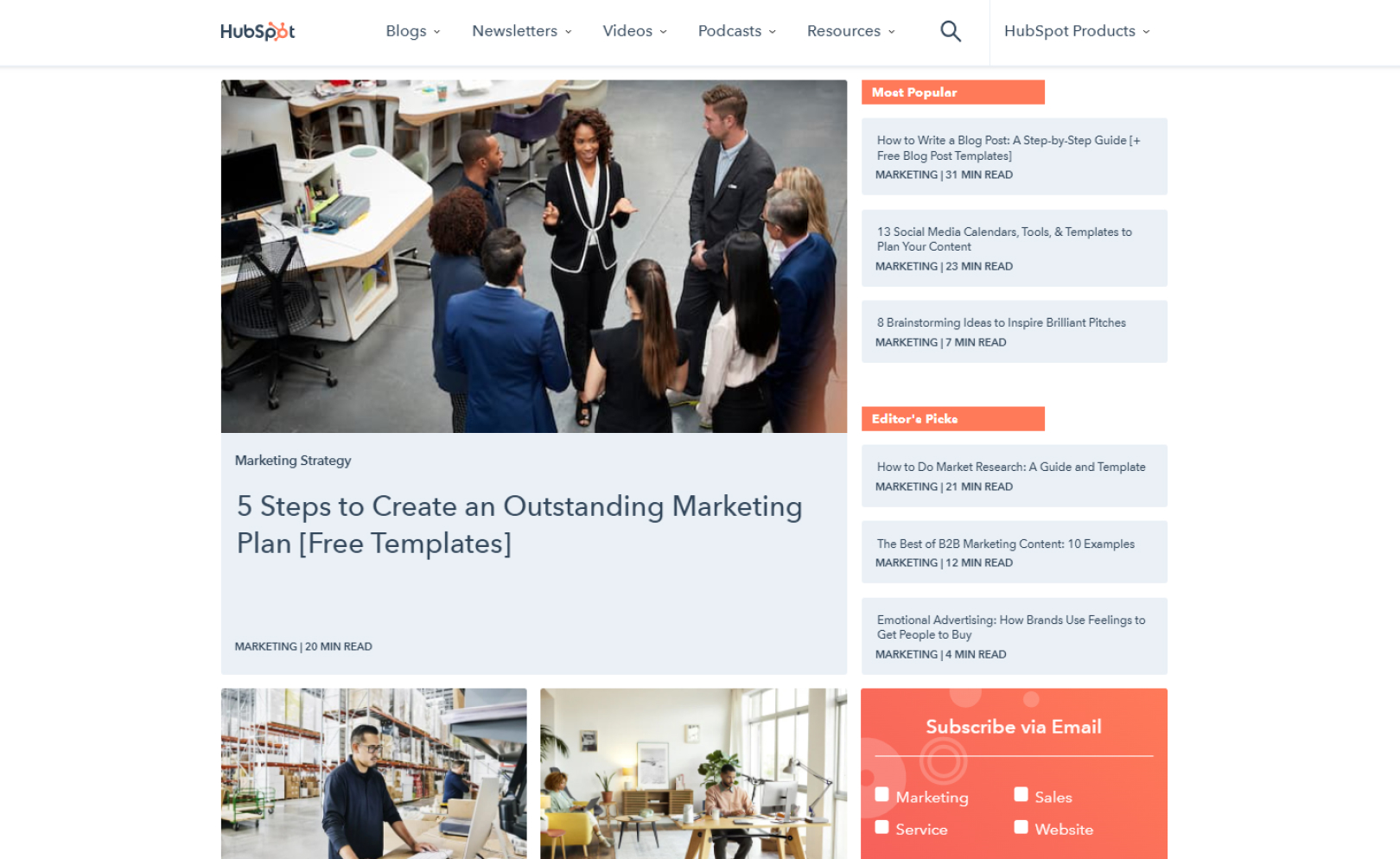
- Blog Dashboard – Your Blog dashboard provides access to all your blog posts – including all of those drafts, scheduled, published, or archived. This is also where you’ll want to go to create a new blog post. You’ll also see quick reports of your blog post views and subscribers as well as the performance of your most recent blog posts.
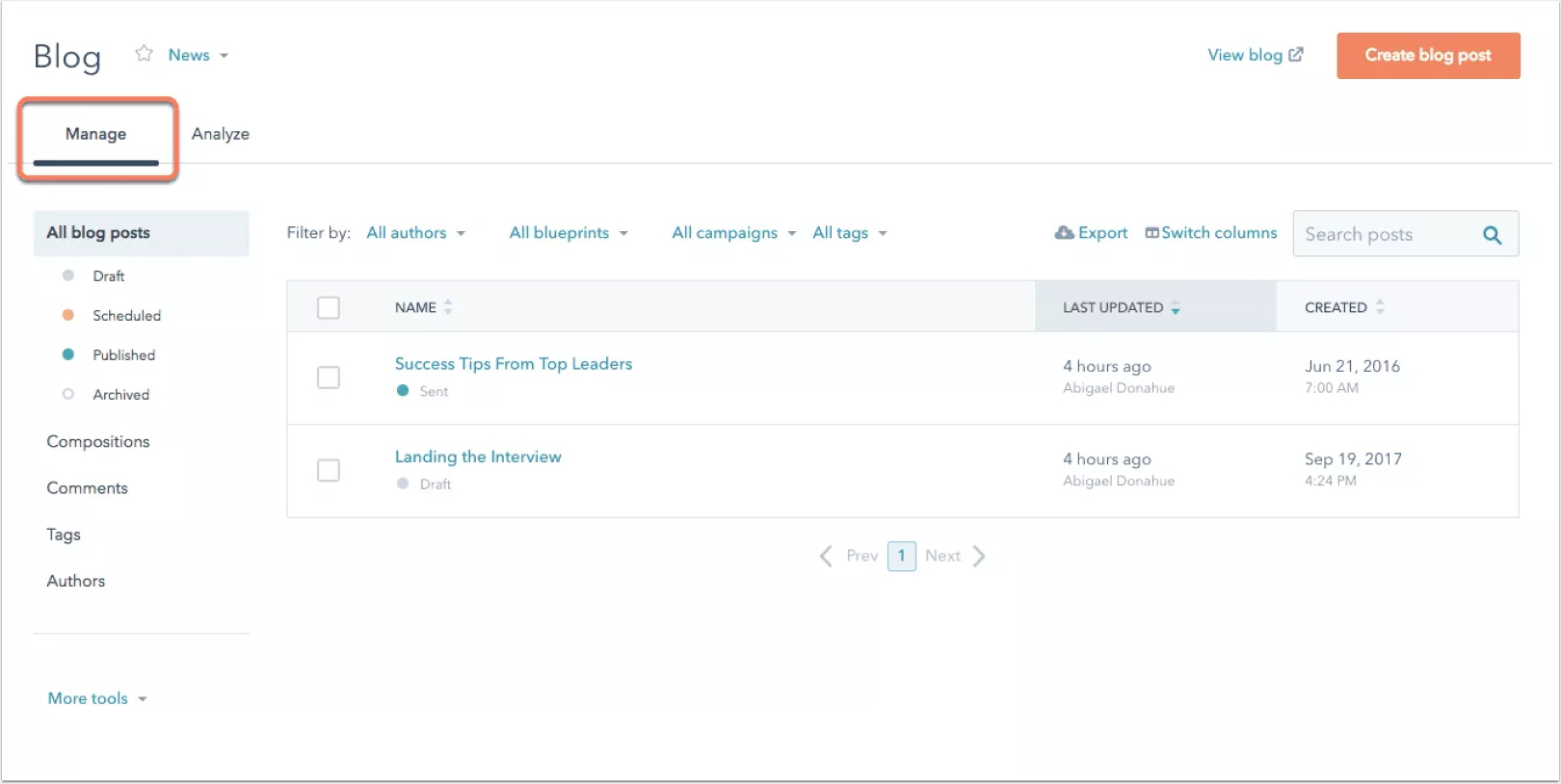
- Tags – The blog tags dashboard helps you identify the topics most commonly used throughout your blog and will provide the ability to edit your topics more efficiently.
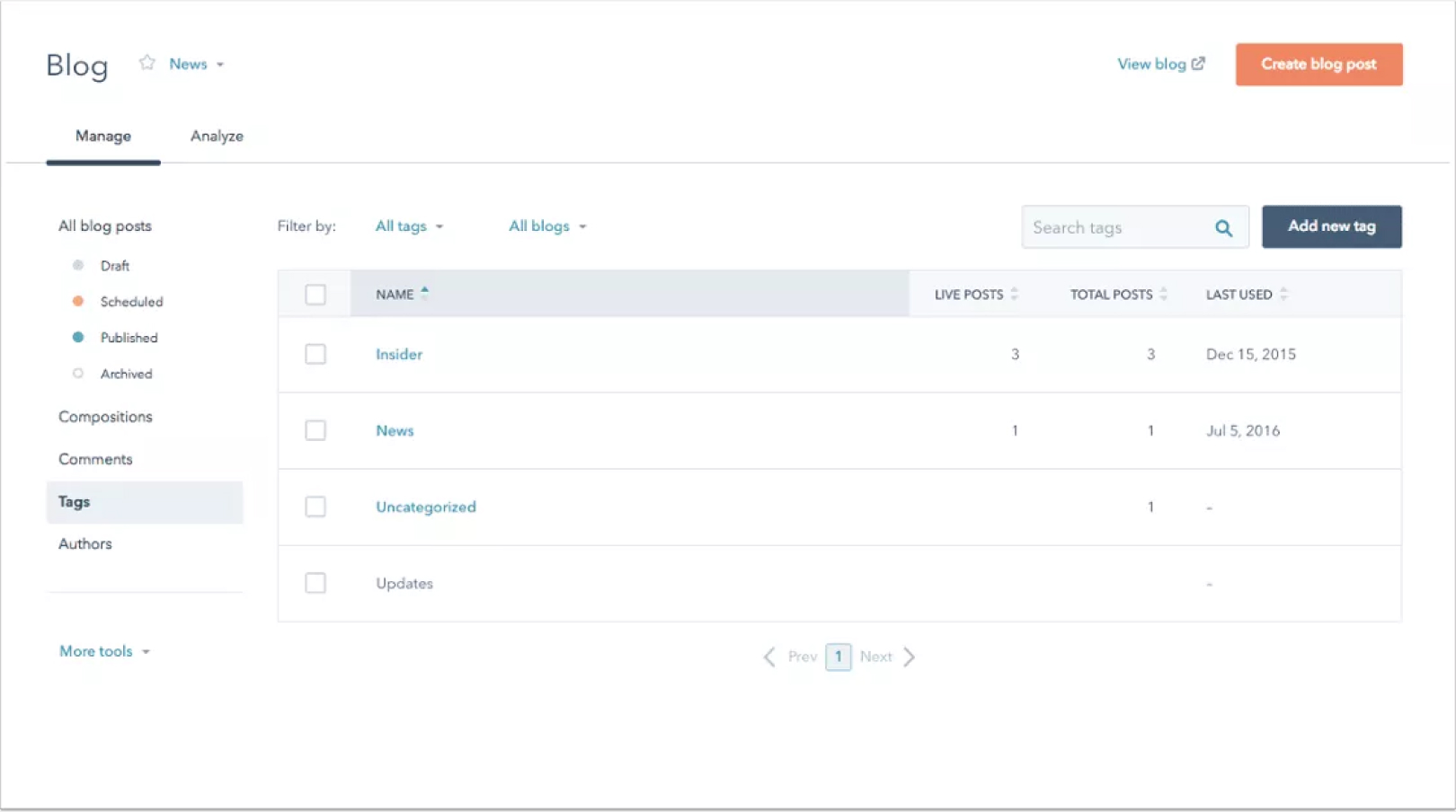
- Authors – Each author has a profile that includes an avatar image, a bio, social media accounts, and other meta information.
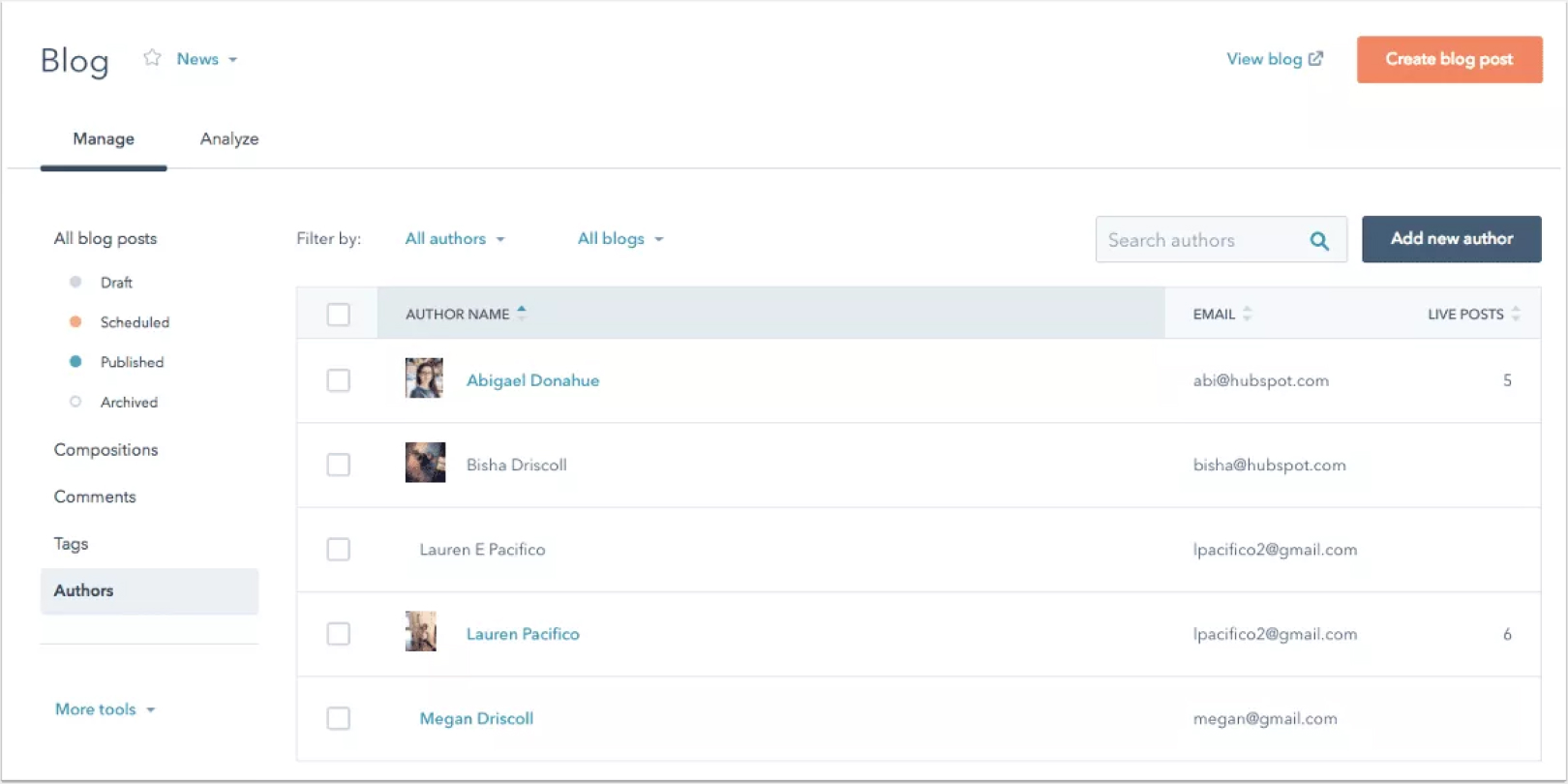
- Comments – The blog comments dashboard allows you to review and moderate comments. Depending on your settings, comments may or may not have to be approved before appearing on your live blog.
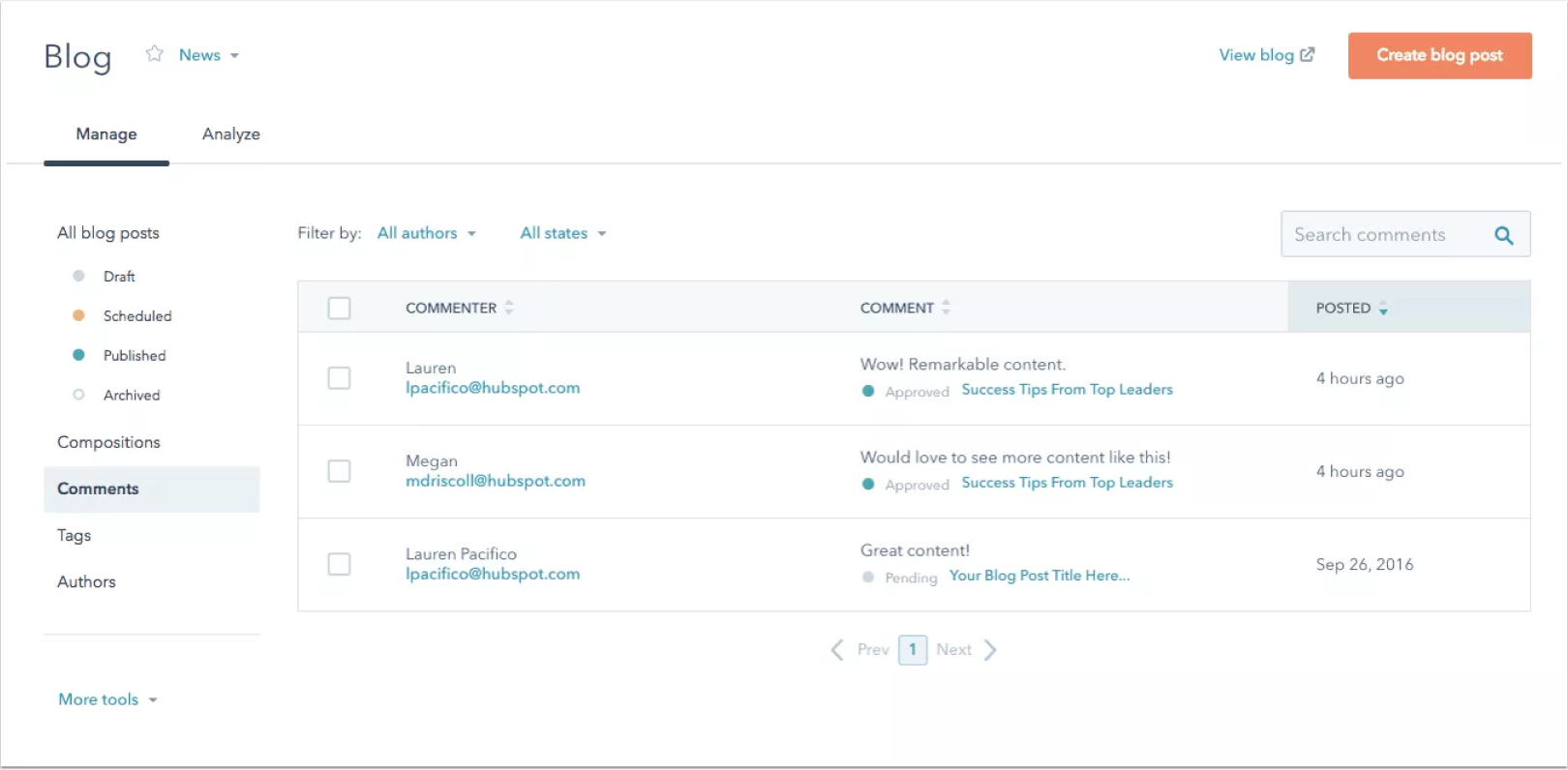
- Subscription – You can create blog subscription emails for instant (each time you post), daily, weekly, and/or monthly subscribers. Subscribers can opt into a certain subscription frequency when they fill out your subscriber form.

- Settings – You can create additional blogs and manage your existing blog options within your blog settings.
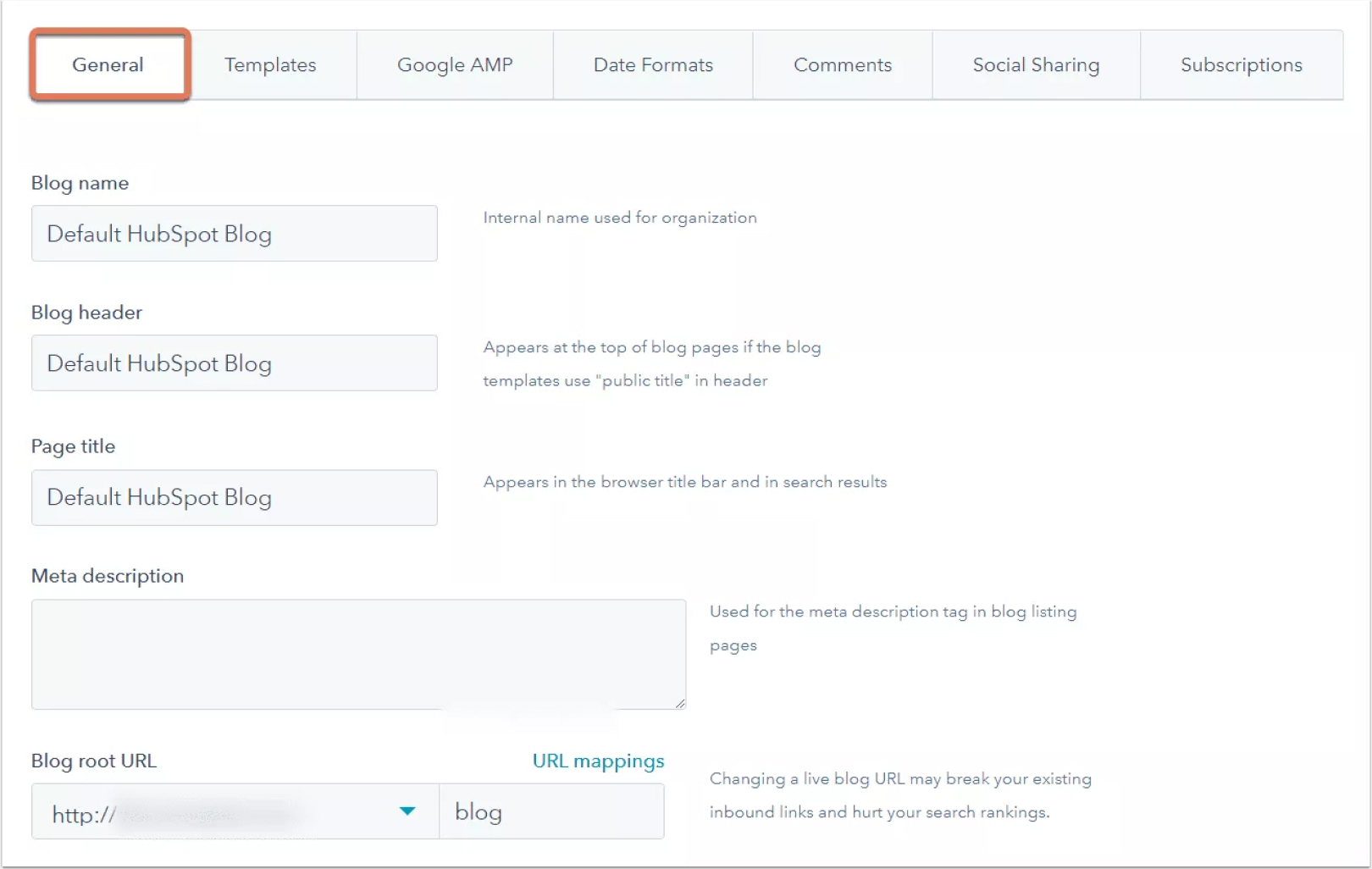
HubSpot CTA
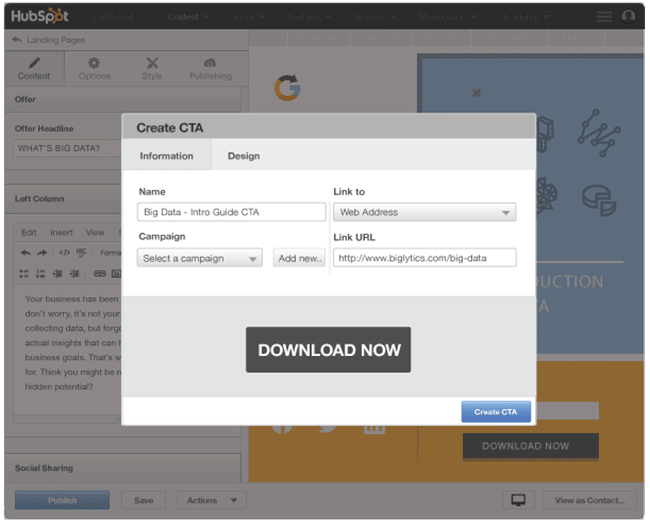
The HubSpot CTA tool will lead you through the process of creating CTAs that convert visitors into leads and leads into customers. From HubSpot’s CTA dashboard, you can:
- Filter CTAs – You have the option of viewing all of your CTAs at once, filtering them by date range, campaign, and type: simple, multivariate, or smart.
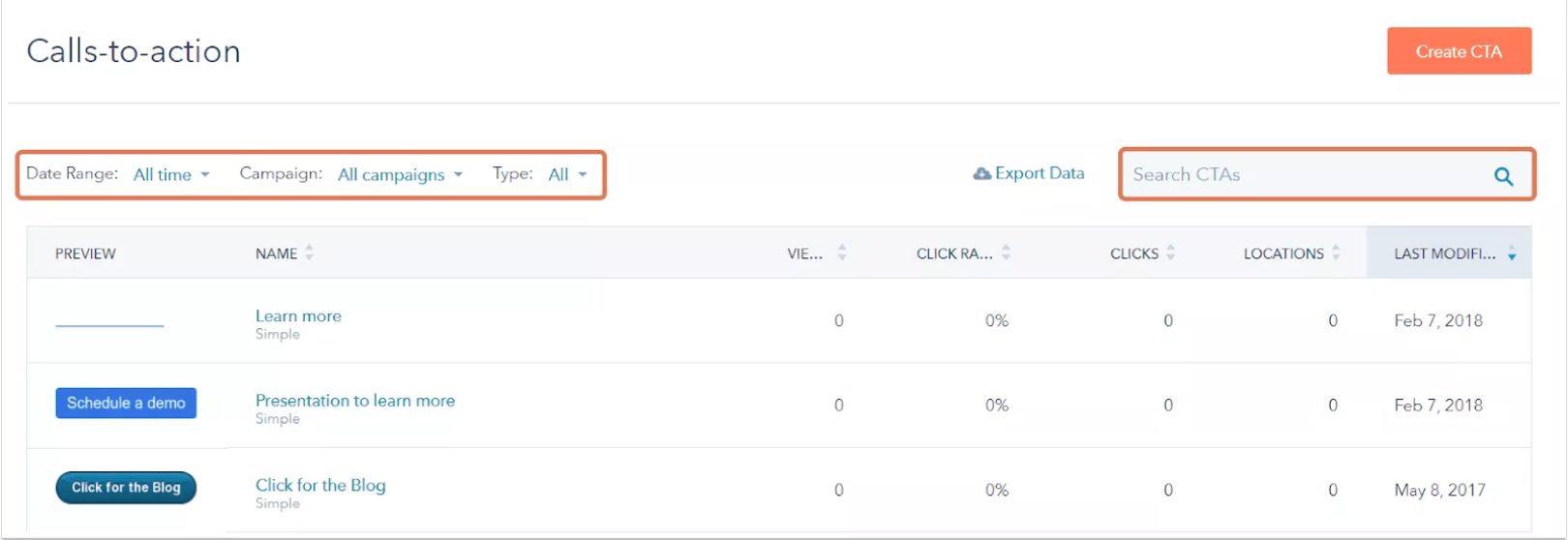
- Analyze CTA Metrics – On your CTA dashboard, the following information will be available to you: CTA preview, CTA name, views, Click Rate, Clicks, Locations and Last Modified.
- Perform CTA Actions – You can choose one of the following actions for your CTA: Edit, Create Multivariate Test, Create smart version, View details, Clone, Embed code, Delete.
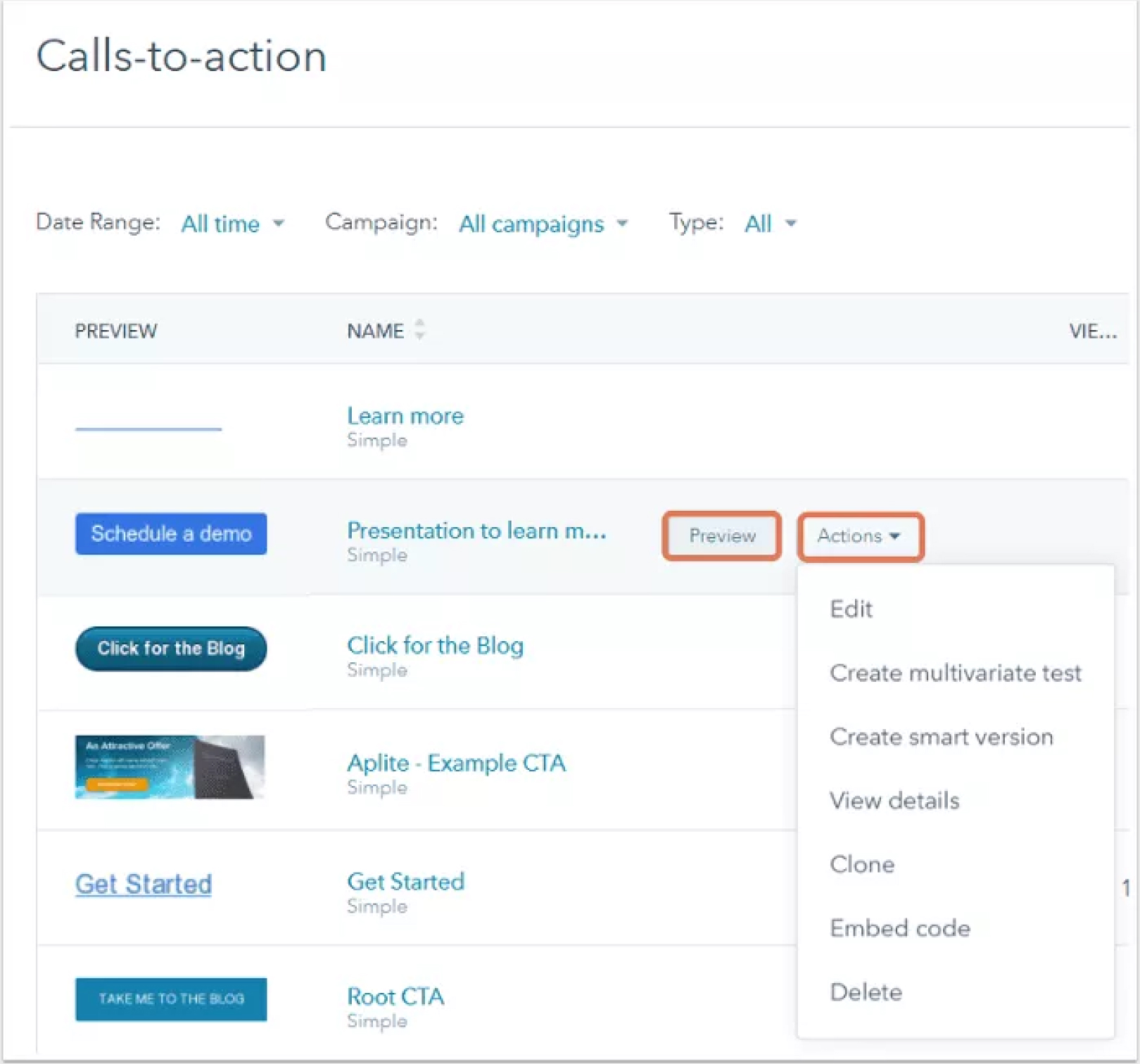
- View In-depth Analytics – Shows the CTA’s views, clicks, and submissions data.
Design Manager
HubSpot’s design manager is a combination of tools that you can use to develop gorgeous looking websites while you create your content in an intuitive interface. The most important tools that are incorporated into the powerful Design Manager are:
- Finder – A space to create and organize your files, templates, modules, and folders.
- Layout Editor – A drag and drop editor for structuring your page, blog, email, and system templates.
- Inspector – This is where you can edit the properties of a layout, module, or group.
- Code Editor – An Integrated Development Environment (IDE) for all your front-end code (CSS, Javascript, or even your own HTML templates)

- Module Editor – Reusable custom modules that you can set up to add advanced functionality to your site that can still be managed by non-technical users.
- File Manager – A file hosting system for all of your site’s assets.
Email Tool
Keeping the interaction with your leads is the core of your inbound marketing. To ensure success with your leads, email marketing is vital. In HubSpot, you have your contact database and the email tool all in one place, which allows you to nurture your leads easier.
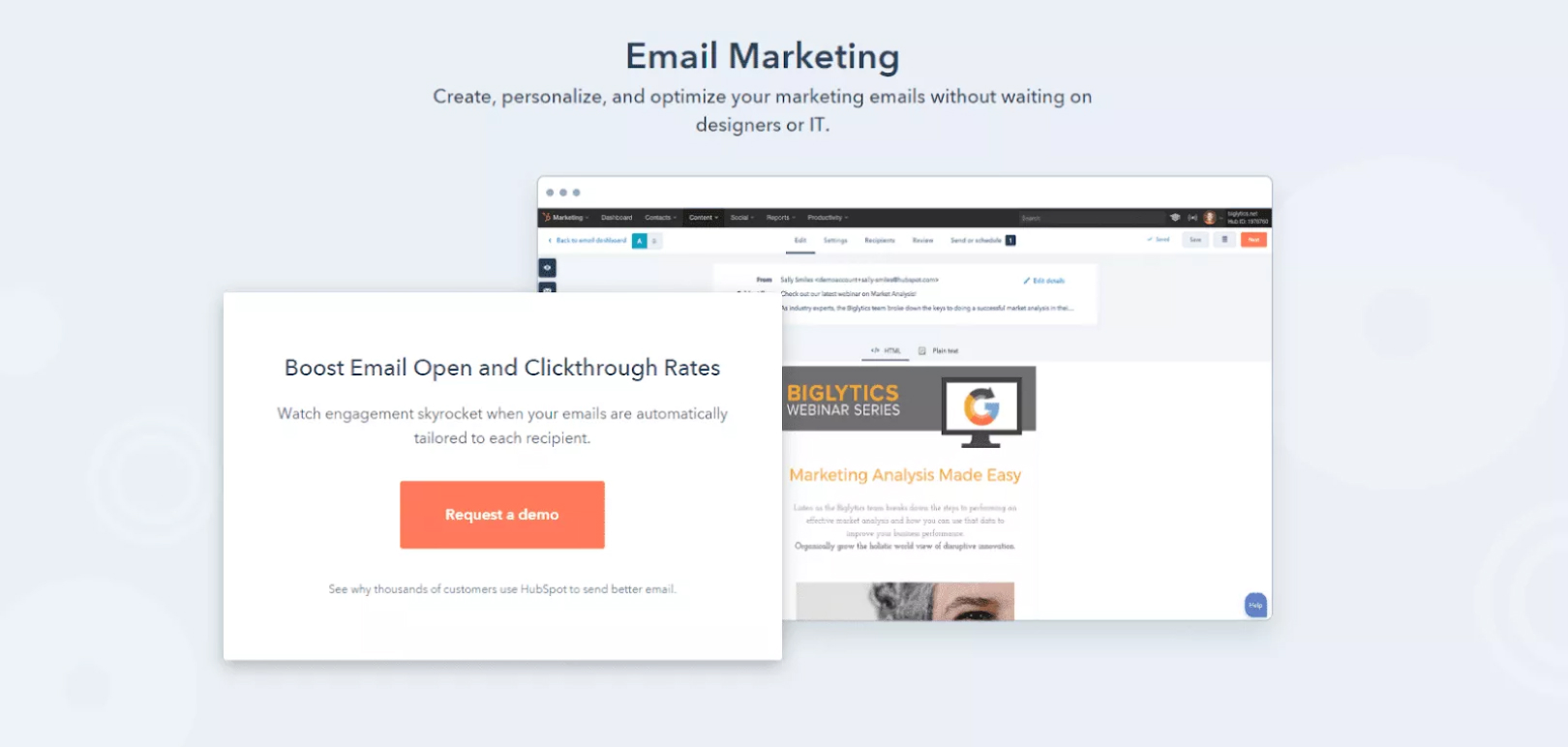
With HubSpot, it’s not just about sending an email – it’s about sending the right email to the right people! HubSpot’s email tool allows you to personalize your email to your contact and grow your contact database.
When you send an email, HubSpot stores the data of your email performance. It is an all-in-one workspace where you can create, edit, design, and evaluate email messages.
To learn how to set up email campaigns with HubSpot’s Email Tool, click here.
Landing Page Tool
HubSpot allows you to develop and test appealing landing pages that will look great on every device and bring more leads for your business. You can choose from the built-in library of mobile-responsive templates or build the landing page from the ground up.
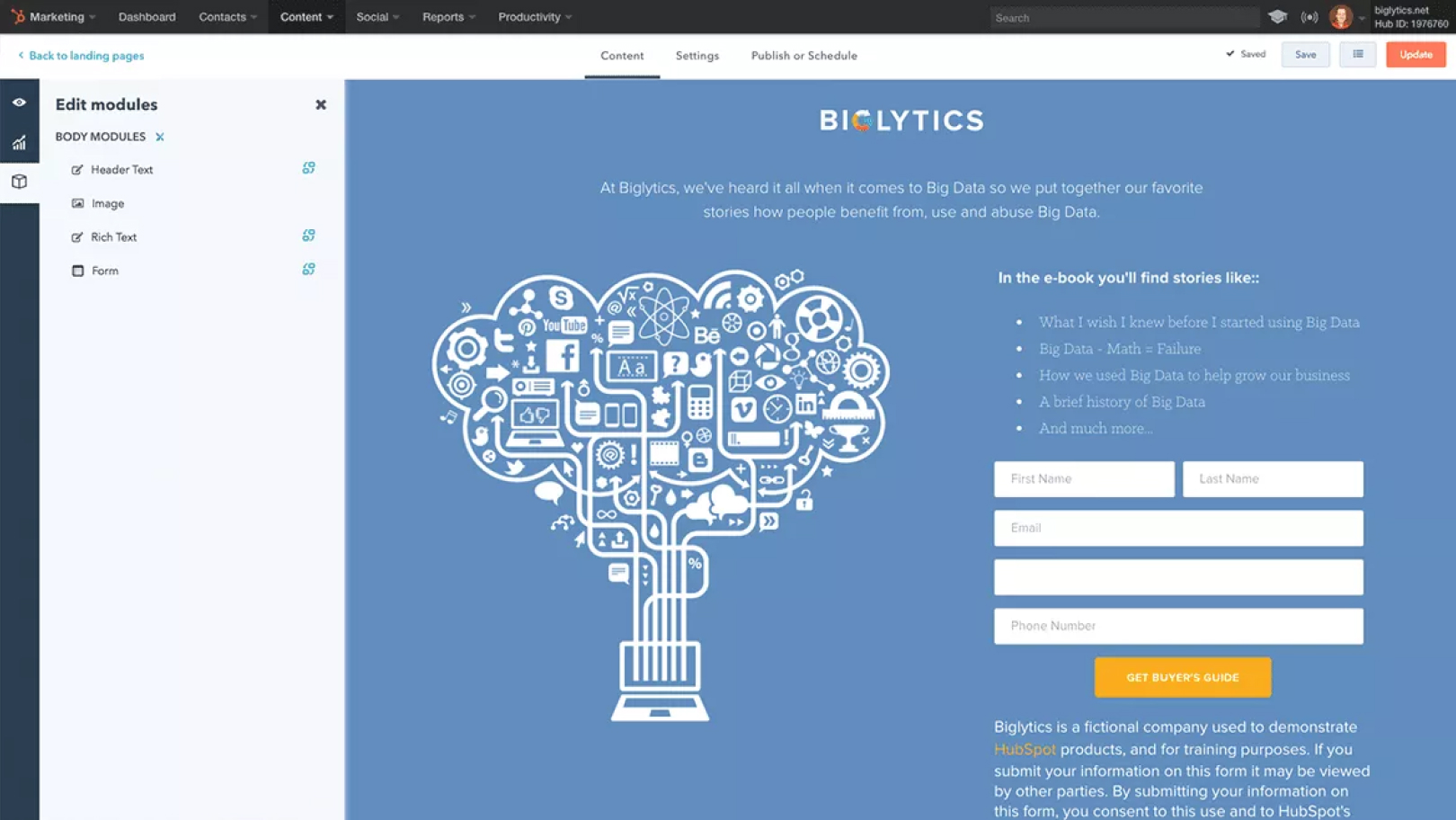
On your HubSpot landing page, you can also insert personalized content, CTA, and forms that will help you improve your conversion rate. The content can also be optimized to be dynamically presented based on the user’s location, device, buying stage, or according to the particular stage in your CRM. You can collect more information about your prospects by using dynamic forms that never ask users the same question twice.

To have a successful inbound approach, you need to continuously test and optimize your landing pages. From HubSpot’s landing page dashboard, you can determine what your best-performing landing page is and get customized suggestions on how to optimize your landing page. You can also A/B test each element of your landing page to see which version brings more conversions.
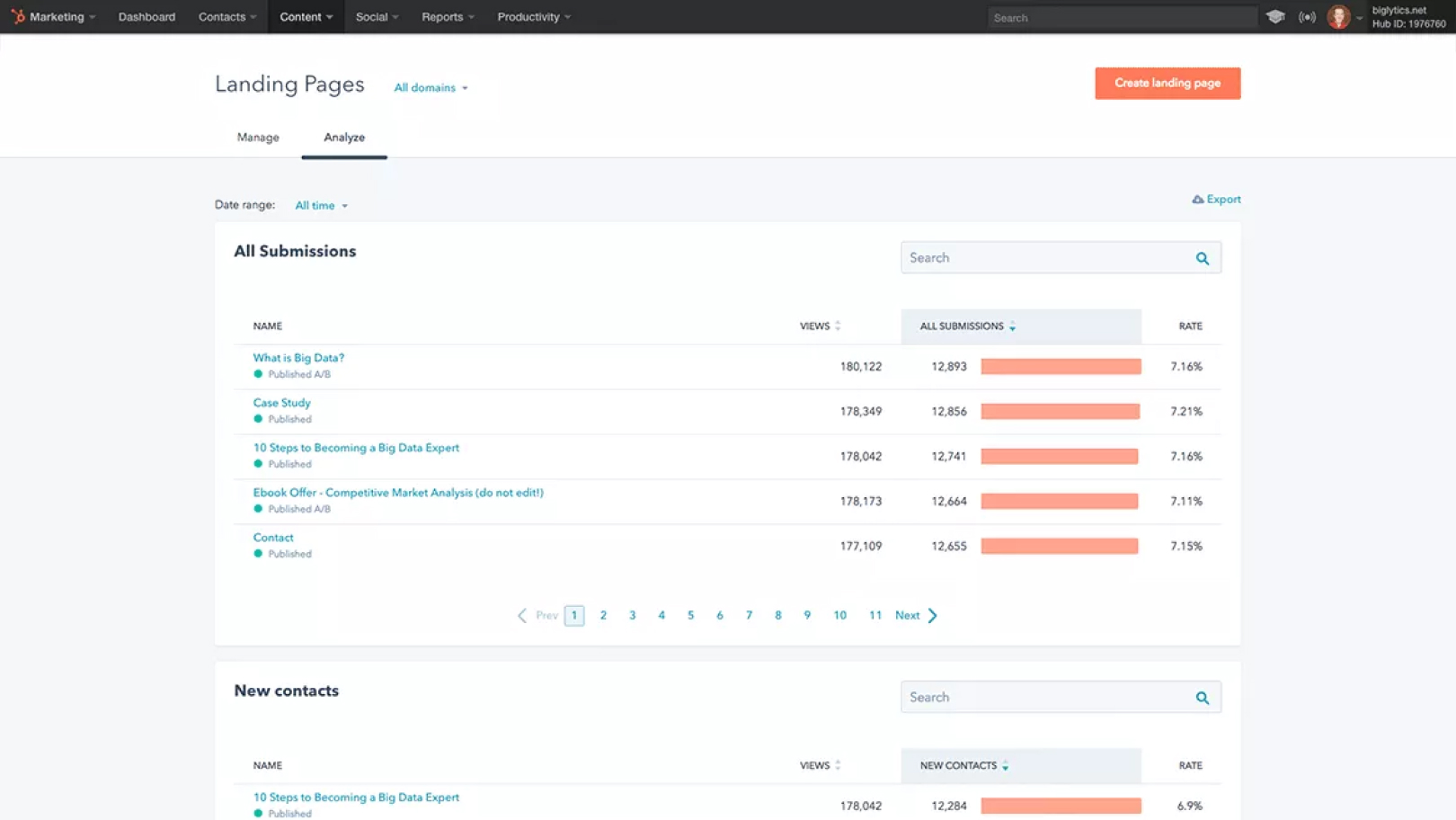
Exploring and Using the CRM Software

Your HubSpot CRM will be the place where you’ll store data about the people and companies that you interact with and monitor your outreach efforts. It is composed of free marketing and sales tools and three main databases:
- Contacts
- Companies
- Deals
In addition to these main data types, the HubSpot CRM also includes your sales and marketing dashboards, tasks, marketing conversion tools, sales tools, and customizable CRM account settings.

HubSpot’s free CRM goes far beyond content management and besides that, it also includes:
- Email Tracking – You’ll know exactly when the lead opens an email, clicks on a link, or downloads an attachment. After that, you can send a perfectly timed follow-up.
- Email Templates & Documents – With HubSpot, you can turn your most effective and repetitive sales emails into templates, and build a library of documents that you can access inside your inbox and share with your entire team.
- Gmail & Outlook Integration – Integration with Gmail, G Suite, and Outlook or Office 365 for Windows. Access email templates, contact and company info, and more right inside your inbox.
- Facebook & Instagram Ads – Lead ads for Facebook or Instagram that automatically capture contact information and sync with your HubSpot account.
- Forms – Mobile-optimized forms, pop-ups, banners, and slide-ins to convert visitors into leads, and add them to any web page.
- Contact Activity – Detailed interactions between a contact and your website in a single place, including page views, form submissions, sales activity, and more.
- Conversations Inbox – An inbox that gives your sales, marketing, and customer service team one place to view, manage, and reply to all conversations from live chat, bots, or team email aliases.
- Meeting Scheduling – A scheduling link that you can share with prospects, giving them the power to book time on your sales team’s calendar.
- Live Chats & Bots – Connect with website visitors in real time to convert new leads, close more deals, and provide better support to your customers by using live chats and bots to automate and scale your live chat conversations.
Marketing and Sales Dashboard
The marketing dashboard will provide you with a summary of your current marketing process and activity. As a HubSpot user, you’ll also have access to the sales dashboard. You can use the drop-down menu to filter your dashboard. You can filter by date range on the marketing dashboard and by data range, owners, team, and pipelines on the sales dashboard.

The reports that are included in your marketing dashboards are:
- Marketing Performance – An overview of your sessions, contacts, and customers over time. From here, you can use conversion rates to determine where the biggest bottlenecks come from and how they change over time.
- Landing Page Performance – Analyzing your landing page metrics along with the performance data of your landing pages. This data will help you understand what works and what doesn’t work when it comes to your landing page conversion rate.
- Blogging Performance – You’ll get a high-level analysis of your blog posts performance, most popular posts, views, and the number of subscribers.
- Email Performance – With HubSpot, you’ll know exactly how your email campaigns perform. You’ll track clicks, sends, open rates for automated emails and standard emails that are sent via HubSpot campaigns.
- Contact Performance – A report on the number of leads, marketing qualified leads (MQL), customers and contacts that are added within a specific timeframe. This will provide you with a snapshot of your most qualified target customers.
The reports that are included in your Sales dashboard are:
- Deal Forecast – The forecasted revenue for deals in your deal pipeline. This is determined by the multiplication of the deal amount of each deal by the deal stage probability. This report showcases all the deal stages
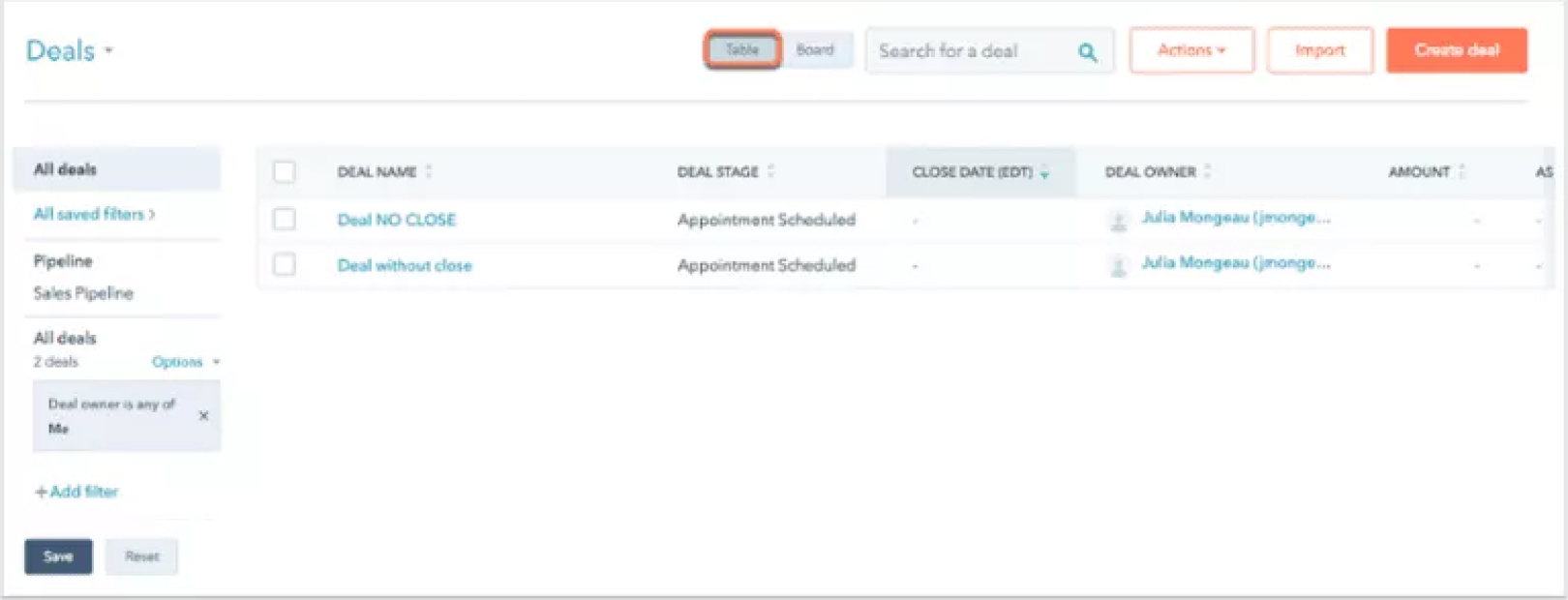
- Deals Closed vs Goal – This report reveals the revenue from closed deals compared to your team’s sales quota or another custom goal. You can use this report to track your team’s progress over time and to help them set better sales goals. This report also includes deals that were closed as won within a specific time frame.

- Team Activity – A flow of recent sales activity from your sales users. While you can filter by date range, this report will show the last 20 activities starting at the end date in the date filter.
- Productivity – A report of the total number of calls, emails, notes, tasks, and meetings that took place in a selected time period.
Contacts and Deals
Your contacts, companies, and deals will be the three core data objects within your HubSpot account. They can be associated with one another along with a unique set of customizable properties. When adding data to the CRM, you’ll store it on the object that’s most specifically associated with the information or action.
Contacts
Your contacts are the core of your CRM. With HubSpot CRM, you can manage your contacts without the busywork. You can also add company and contact records with a single click, log sales activities automatically, and easily keep your records up to date.

With HubSpot CRM, you can create up to one million contact and company records! You can add the contacts manually by using the prospect’s corporate email address or bring them from your inbox or form submissions. After that, HubSpot’s software will develop a related company record and fill it with revenue, niche, and contact details from its database.
Companies
By using the Companies dashboard, you can categorize your contacts and group them according to their company information. Same as in the Contacts dashboard, you’ll be presented with a table of the companies that are currently in your database, which can later be customized to display different company properties or filtered to restrict which companies appear.
HubSpot automatically associates companies and contacts based on email domain and company domain name. Associated contacts are displayed on the associated company’s record and vice versa.
Deals
With HubSpot CRM, once you qualify a lead, you can create a deal that analyses and tracks the revenue opportunity. By linking the deal with contacts and companies in your HubSpot database, you can create a relevant context and track the deal’s data from one place.
In the Deals dashboard, you’ll have two options:
- Table – An overview of your deals. You can customize which deal properties are displayed as columns in the table.
- Board – Displays your deals in columns based on the stage of the deal and provides you with a visual presentation of your deal pipeline.
You can use your contacts’ properties Lifecycle stage and Lead status to qualify your leads until you’ve received or noted a strong level of interest or revenue opportunity.
You need to create your deals at the moment when you assess that the prospect makes an action towards bringing you revenue.
Just like you use contacts and company properties to collect information, your deal properties are used for storing information about your deals. With deal properties, you can store information regarding where the deal is in your sales funnel, the estimated revenue of a deal, and more.
Tasks
Your tasks dashboard is an overview of your progressing sales tasks. You can filter your tasks based on owner, due date, status, or description. There are two ways to create a task in HubSpot CRM:
- From a contact, company, or deal record
- From your tasks dashboard
There are two options to view the tasks dashboard:
- Table – Shows you a list of your tasks.
- Board – This shows your tasks in columns based on their status and gives you a visual representation of your tasks.
You can create a task from your tasks dashboard and connect them with companies, contacts, and deals. By creating tasks queues you can organize your sales to-do-list and finish them more efficiently. You can also add a specific task to an existing queue.
Sales Tools
Your HubSpot CRM will also incorporate numerous sales tools within your sales navigation menu. These are tools that make your overall sales process more efficient without sacrificing any personalization or your inbound marketing strategy.
The HubSpot sales tools live in your account, and they can be accessed in your email client with either a connected inbox, the HubSpot Sales email extension/add-in, or both. They include:
- Activity Feed – Your activity feed provides a view of email notifications and other types of engagements with your leads. You can quickly search your activity feed by searching for a specific word, email, or even company domain.
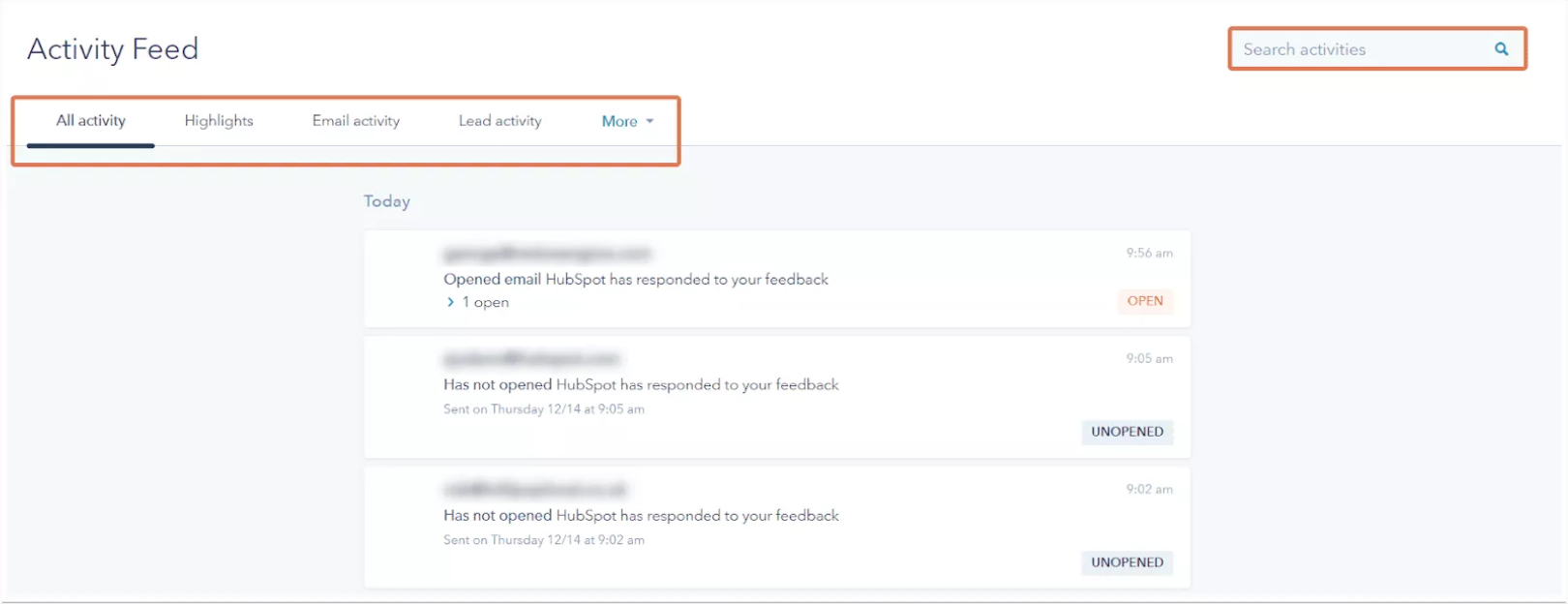
- Snippets – They can save you a lot of time when you compose your email messages by enabling you to reuse short text blocks when sending emails from contact, company, and deal records. They can also be inserted in email templates, sequences, in messages, or in an Outlook email or Gmail email message.
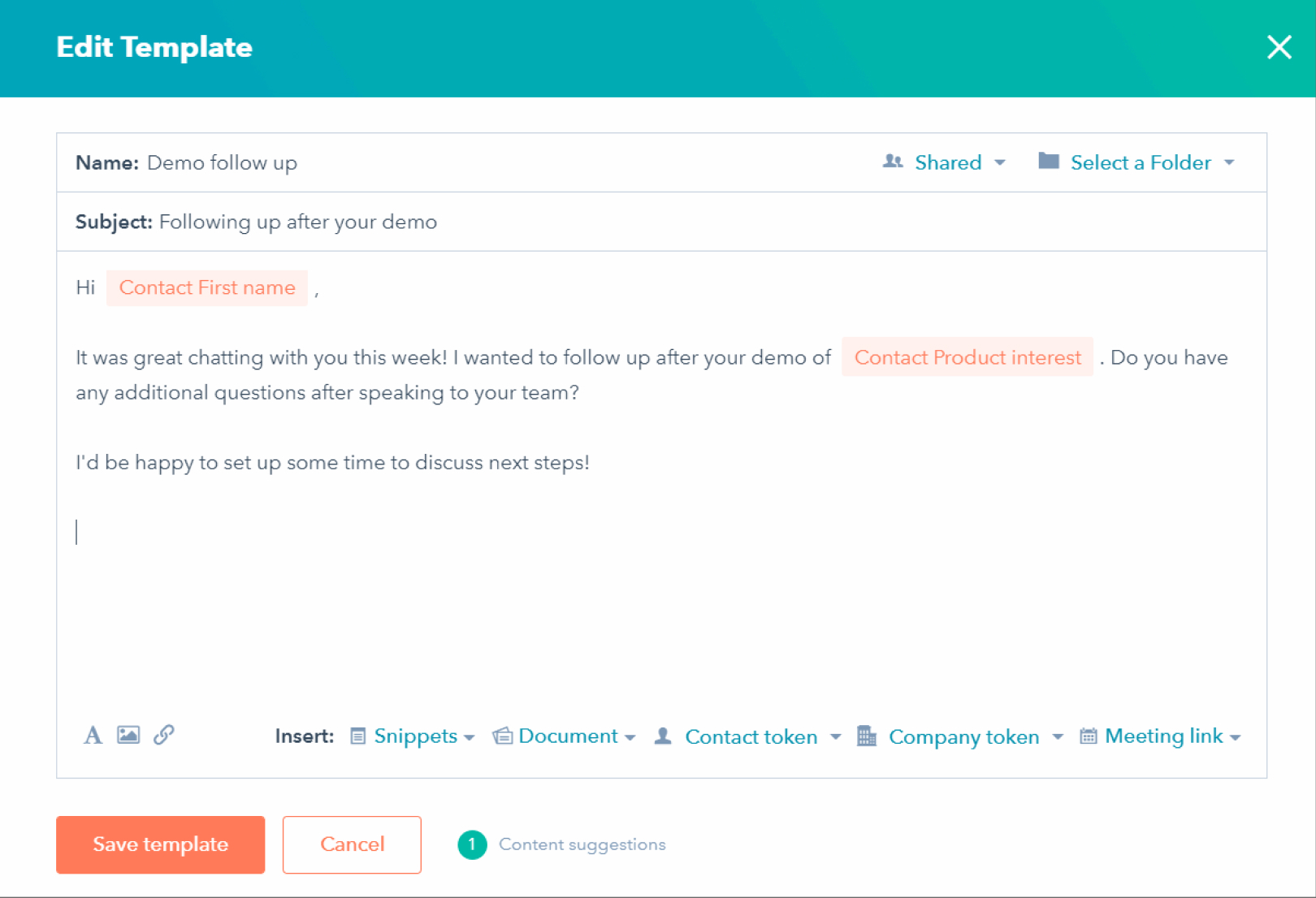
- Templates – Just like snippets, your templates will be a real time-saver when you engage with your contacts. Your templates are reusable email messages that you can send to your contacts. Once your template is created, you can send them to contacts from a contact, company, or deal record in HubSpot. You can also send them to email recipients using the HubSpot Sales email extension or add-in.
- Documents – With HubSpot’s Documents, you can build a library of sales content to share right from your inbox, from a CRM email, or from a template or sequence. You can also see when your contacts interact with your documents and analyze their effectiveness.
- Meetings – You can integrate your meetings tool with your Google calendar and send a meeting link to prospects in order to book the time that’s more appropriate for both parties. The meetings tool eliminates the back-and-forth of finding a time that works, instead presenting your prospect with meeting times based on your calendar availability.
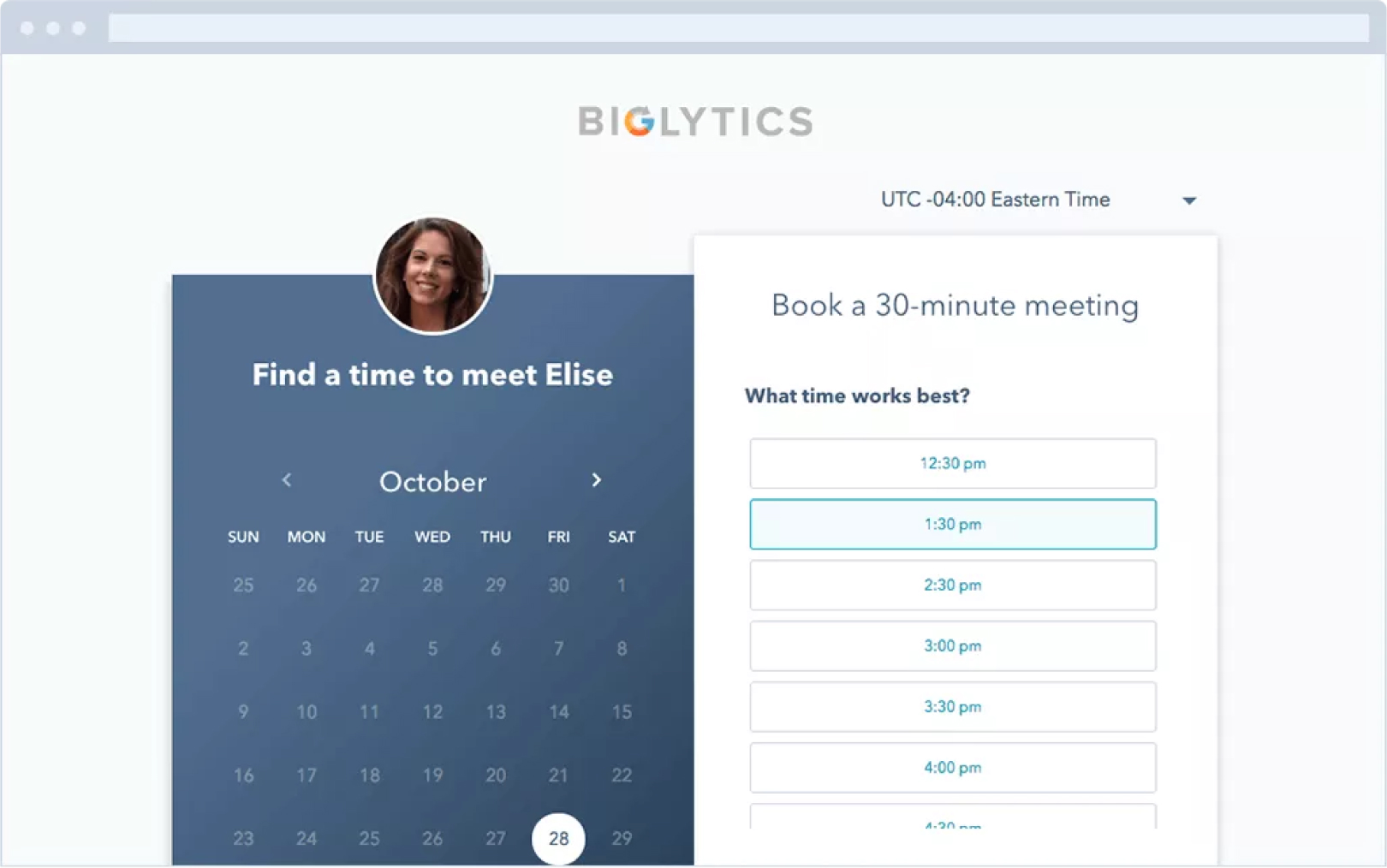
- Sequences – You can set up a sequence of personalized messages that will be sent to your contacts over time. Put together your sales email templates and tasks to create a string of correspondence ensuring that you’re capturing interested prospects and moving them along your sales funnel.
- Prospects – The prospects tool stores information about potential prospects that visited your page. You can also set up daily email digests to stay up to date on prospects who know your brand and visit your website.
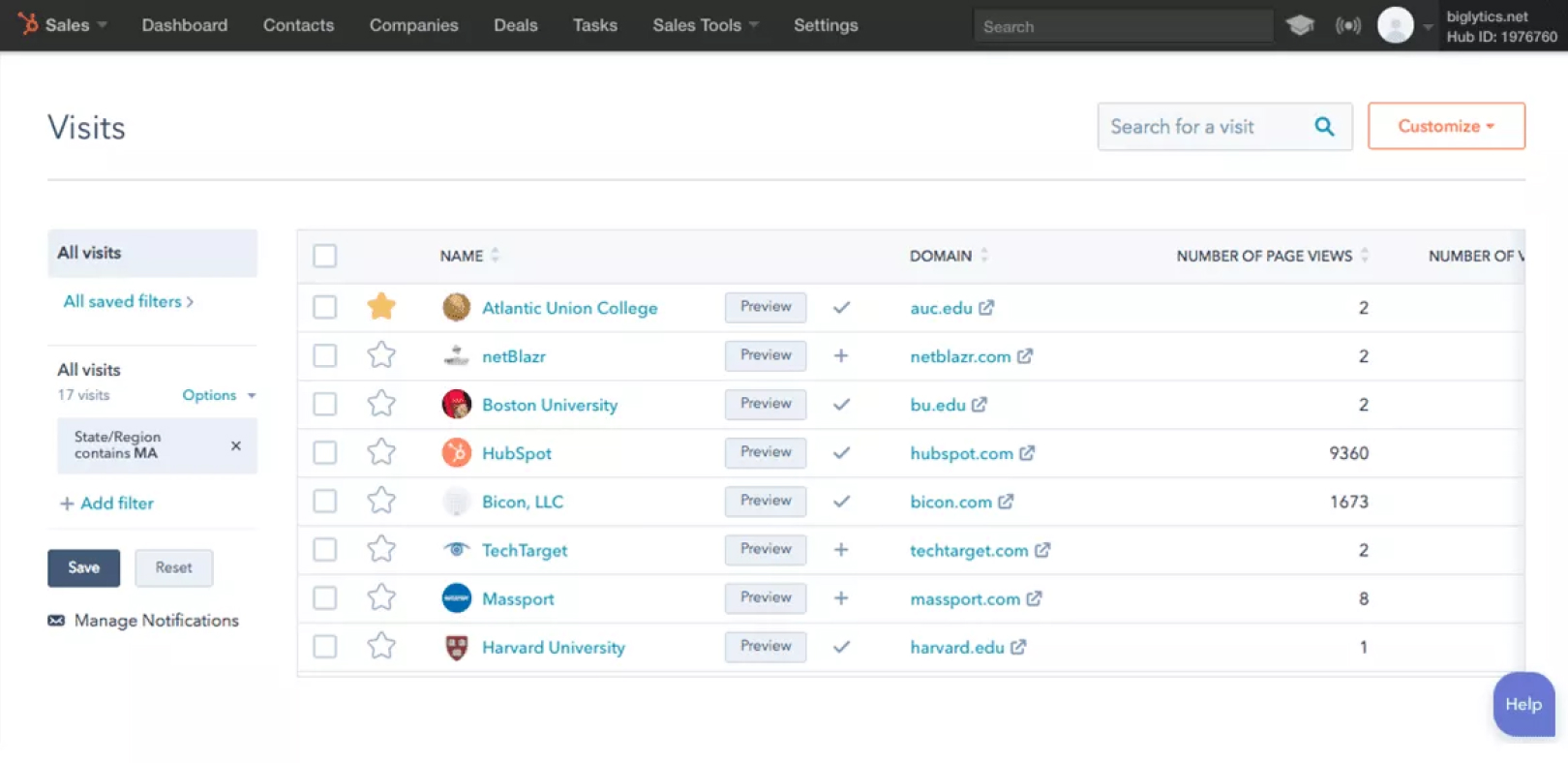
- Workflows – You can use them to automate your sales and marketing processes. Here, you can automate the processes of sending email messages, tasks creation, projects assignments, and much more.
Some of HubSpot’s sales features such as (Sequences, Office 365 add-in, Send Later) require you to have a connected inbox. When you connect your inbox with HubSpot, you can send emails from CRM records, log incoming replies to your emails in the CRM, and more. A connected inbox is also required for sending email from the HubSpot CRM.
Wrapping Up
If you want to become a champion in Inbound Marketing, using HubSpot has the power to take you all the way to the finish line. Remember that inbound marketing is a value driven-process. Consumers today don’t want to be sold to, they want advice and buy according to their own decisions.
This is why as an entrepreneur, you must utilize a tool like HubSpot to its maximum, in order to develop the best possible experience and content for your target audience. With software like this, there are no limits, and you can transform your campaign and reshape your business to grow straight away.




